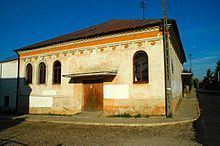Gmina Krynki Area 3.85 km² | Population 2,709 Local time Saturday 4:41 PM | |
 | ||
Weather 6°C, Wind S at 14 km/h, 73% Humidity | ||
Krynki druga republika krynecka
Krynki [ˈkrɨŋkʲi] (Belarusian: Крынкі Krynki) is a town in northeastern Poland, located in Podlaskie Voivodeship along the border with Belarus. Krynki is famous for its history and its old buildings. It lies approximately 24 kilometres (15 mi) south-east of Sokółka and 45 km (28 mi) east of the regional capital Białystok.
Contents
- Krynki druga republika krynecka
- Map of Krynki Poland
- History
- Jewish heritage
- The Holocaust
- Points of interest
- References
Map of Krynki, Poland
History
Krynki received town privileges in 1569. Throughout history, it was an important textile, leather and pottery center. In 1914, the town's population was 10,000 people, about 80 percent of them Jewish. The remainder was made up of Christian Poles and ethnic Belarusians. Krynki used to be a multicultural town prior to World War II, and before the Holocaust in occupied Poland. Today, the majority of Krynki's citizens are Catholic, but there is a Belarusian minority still present. Krynki lost city rights in 1950 in Stalinist Poland due to significant loss of population, but regained them in 2009.
Jewish heritage
Jews began living in Krynki in the 17th century when the Polish king Władysław IV Vasa invited them to town to boost trade and manufacturing. From that moment, the Jewish population continued to grow and their culture flourished.
A notable part of Krynki's history was the Jewish labour movement of 1905. In that year, Jakow Pat led Jewish workers and created the independent Republic of Krynki in defiance of the Russian imperial rule. After World War I Poland returned to independence and democracy. The Jews began emigrating to Palestine and the United States for greater economic benefit.
The Holocaust
During World War II, Krynki was occupied by the Soviets from 1939 until 1941 and by Nazi Germany after Operation Barbarossa. The German authorities began the reign of terror by executing 30 prominent Jews, and in December 1941 created a Jewish ghetto in Krynki. The Jews from neighbouring settlements were deported to Krynki including 1,200 inhabitants of Brzostowica Wielka. Around 6,000 people were imprisoned there with insufficient food and severe overcrowding. The liquidation of the ghetto began in November 1942. The ghetto inmates, men, women and children, were deported to the Nazi transit camp in Kiełbasin and sent off aboard Holocaust trains to the Treblinka extermination camp.
The Jewish population, however, did not remain passive. During the ghetto liquidation action, a number of Jewish insurgents responded by shooting at the Nazi police including their gun-wielding Belarusian auxiliaries, and many escaped into the forest. Today, no Jews live in Krynki, but the memory of them still lives on.
